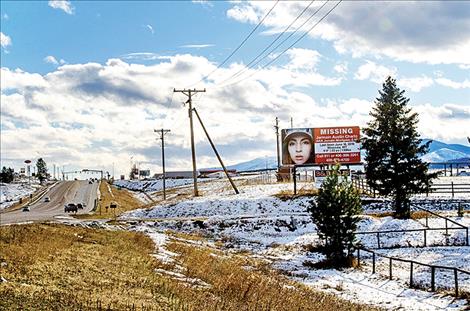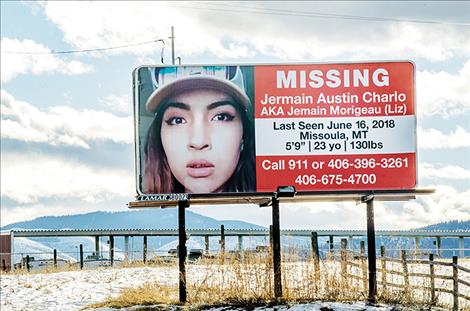U.S. senators respond to MMIW 'epidemic'
Tester, Daines among group pushing for solutions to nation-wide crisis
Hey savvy news reader! Thanks for choosing local.
You are now reading
3 of 3 free articles.
People driving south on U.S. Highway 93 outside of Missoula will pass a billboard with the word “Missing” in prominent letters next to a picture of a Salish woman.
Jermain Austin Charlo was last seen on June 16 in Missoula, according to the information on the billboard. The Dixon resident sometimes uses another family name and calls herself Jermain Morigeau or the nickname “Liz.” She is 23 years old, five foot nine and weighs about 130 pounds.
The night she disappeared she became one of the many missing and murdered indigenous women across the United States, a community of women with such a high percentage that they have been given the name MMIW.
The data isn’t easy to find and could be incomplete, but information compiled for the 2018 State-Tribal Relations Committee reports that 30 percent of Montana’s missing are Native American women and girls. The number is high on its own, but it becomes extreme considering the Native American population in Montana, according to the United States Census Bureau, is only 6.7 percent, which includes men.
Confederated Salish and Kootenai Tribal Police Chief Craige Couture said Jermain is currently the only missing Native American woman in his records who was living on the Flathead Indian Reservation during the time of her disappearance. He said the low number doesn’t mean that there isn’t a problem. He explained that women or girls with local tribal affiliation are counted in the place where they were living at the time of their disappearance. Darlene Billie, 55, of St. Ignatius went missing in October 2017. Her remains were found in North Dakota in September of this year.
During a United States Senate Committee on Indian Affairs in Washington, D.C., on Dec. 12, senators, experts and witnesses gathered to discuss the nation-wide problem. Senator Jon Tester, Montana, said the meeting was held “because we have an epidemic on our hands.” He noted in a press release that tribal leaders in the state told him that a total of 20 Native American women have gone missing since the beginning of 2018. He said that only one of those women has been found.
“You cannot step foot in Indian Country without hearing a heartbreaking story about this growing problem — that is why we are here today,” Tester said at the meeting. “We need to know what’s happening and what exactly can happen to solve this problem. Because these are people, these are families, these are communities that our law enforcement agencies need to look out for.”
Senator John Hoeven, chairman of the Senate Committee on Indian Affairs, explained that the Departments of Justice and Interior are required to investigate and prosecute homicides committed against or by Indians on tribal lands. He said it’s “less clear” who has the responsibility for investigating cases of missing Indigenous individuals. “This lack of clarity has left tribes and families unsure of who to call for help and has contributed to our lack of knowledge on the scope of the problem.”
Charles Addington, deputy associate director for the Bureau of Indian Affairs, Office of Justice Services, Washington, D.C., said several times during the meeting that coordination between responding agencies was missing. He also said law enforcement rely on evidence and leads during investigations and without them, the work is more difficult. He said training all responding agencies including search and rescue in the same manner would help preserve evidence. He also recommends faster action when an incident is reported.
“We have to have more attention immediately when someone reports someone missing regardless of the circumstances,” he said. He explained that the protocol should be to start an investigation and collect evidence as soon as possible, which could end up meaning an individual is determined to simply be at a friend’s house and not in danger.
Addington said half of Native American women across the country have been sexually assaulted and more than a third have been raped, which is a rate two and a half times that of white women.
Senator Tom Udall, New Mexico, took his turn during the meeting to say three core issues were adding to the MMIW “crises” including poor coordination between responding agencies, limited data and insufficient resources. He said these issues were “slowing progress” in all aspects of improving tribal public safety. In regards to MMIW, he said poor coordination is straining the resources of an already overextended law enforcement. Limited data, he said, means communities won’t know where to target resources.
Without the data, people can only speculate about what is causing the problem. Addington said it is “widely believed” that there may be a correlation between opioids and other narcotics abuses to MMIW, human trafficking and domestic violence, but without sufficient data, it is “difficult” to draw a solid conclusion.
“Federal agencies must develop concrete solutions to improve agency data collection to ensure those crimes are being tracked and investigated appropriately so that any trends can be properly identified and addressed,” he said.
The BIA currently collects monthly crime statistics from BIA law enforcement programs and submits them to the Federal Bureau of Investigation, but missing persons or domestic violence statistics are not tracked, he said. Savanna’s Act, passed by the Senate in December, is soon to change that problem. The name comes from Savanna LaFontaine-Greywind, 22, a member of the Turtle Mountain Band of Chippewa in North Dakota. She disappeared in 2017 and was murdered during a fetal abduction.
Addington said “in light of the significant data collection challenges facing MMI persons, the BIA has partnered with the DOJ’s National Missing and Unidentified Persons System (NamUs) to create new data fields in their system to specifically capture tribal affiliation data. The new fields are expected to be operational Jan. 1, 2019.”
Gerald LaPorte, director of the Office of Investigative and Forensic Sciences, National Institute of Justice, said NamUs was launched nationally in 2007 as a tool to help identify deceased and unidentified people. The program utilizes a national database of information including fingerprints and DNA results to try and identify people.
In addition to Savanna’s Act, Hoeven said legislative hearings related to the issue of public safety, law enforcement, victim’s services and human trafficking in Indian Country have been on the Senates’ agenda during this Congress. He said several initiatives were passed including the Ashlynne Mike AMBER Alert in Indian Country Act to expand the child abduction alert warning to Native American reservations. Ashlynne Mike was an 11-year-old Navajo girl who was abducted and murdered in New Mexico in 2016. The bill was named after the child because authorities did not issue an AMBER Alert for her until the day after her family reported that she was abducted.
The Survivors Act was also passed in the Senate. The bill directs the Attorney General to review, revise and develop law enforcement and justice protocols appropriate to missing and murdered Indigenous people.
The National Day of Awareness for Missing and Murdered Native Women was designated on May 5 to draw attention to the issue. Hoeven said more initiatives and work are being done. “It’s past time that we understand the scope of the problem and work towards viable solutions,” he said.
Robert Johnson, assistant director of the Criminal Investigative Division of the Federal Bureau of Investigations, Pittsburgh, verified during the meeting that agents sometimes work 80 hours a week, which provides insight into another issue discussed during the meeting: investigating agencies including local law enforcement on reservations were said to be understaffed.
Tester said: “We’ve got issues in Indian Country. We’ve got issues of poverty. We’ve got issues with drugs, and inadequate manpower with tribal law enforcement. We’ve got to find solutions.”
Senator John Barrasso, Wyoming, said crimes against American Indians and Alaskan Natives, men and women, are under-reported, under-investigated and under prosecuted. He said access to federal data is needed to identify risk factors in tribal communities.
Senator Heidi Heitkamp, North Dakota, said, “We know we have a problem.” She said action needs to be taken to solve it. “Just because people have been marginalized historically doesn’t mean we are going to tolerate this going forward.” She said later during the meeting that violent crimes against Native American women need to be prosecuted. “When you don’t have prosecution, you have no deterrents, and it’s open season on people who live in Indian Country.”
Senator Steve Daines, Montana, said Native American women face a murder rate higher than the national average. “If these numbers were seen in any other community there would be far greater public outcry. For too long, these stories of women and girls have gone unheard.” He called the problem an epidemic.
Daines introduced Kimberly Loring HeavyRunner who advocated for her sister Ashley Loring HeavyRunner who is still missing from the Blackfeet Reservation. She was as last seen own June 12, 2017.
On the Flathead Indian Reservation, Jennifer Morigeau waits for her daughter Jermain to come home. She can’t share the details of the open investigation but believes her daughter was taken. She said Missoula Police Department Detective Guy Baker is working on the case.
“If you see her, don’t approach her,” she said. Morigeau explained that her daughter could be held against her will and any involvement from the public could be dangerous and also cause the people involved to flee with Jermain. She said people should call 9-1-1 immediately.


















